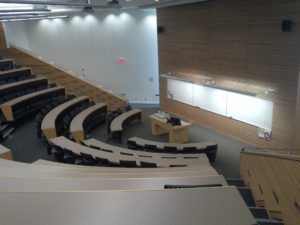
Many years ago, we began the CTE Blog in order to engage with ideas in a less formal way for our various publics. Over time, we’ve had a small number of loyal followers (thanks!) and a wide readership for certain posts or series of posts. The blog has been a space for CTE staff, including our talented graduate students and undergraduate co-op students, as well as occasional faculty guests, to convey information, advice, and opinions from week to week and month to month since Fall 2008. After careful consideration throughout 2017, though, we have come to the conclusion that our efforts are better placed elsewhere, for now. The blog will continue to exist as an archive.
It’s impossible to do a proper roundup of all 450 posts to date, but some of our more popular posts have been:
- Chris Ray, former Co-op student, on using concept maps instead of linear notes for classes
- Crystal Tse, Instructional Developer, on debunking learning styles myths and debunking popular brain myths
- Trevor Holmes, Senior Instructional Developer, on writing effective letters for teaching awards
- Veronica Brown, Senior Instructional Developer, on the affective domain (a series)
- Guest posts by, among many others, Shannon Dea (Philosophy), Josh Neufeld (Biology) and Francis Poulin (Applied Mathematics)
Once in a while, we may end up Tweeting or otherwise referring to some of the rich resources that have come out of this ten-year experiment. We continue, of course, to add Teaching Stories and to revise our popular Teaching Tips on our Resources section of the CTE website. These latter receive millions of hits globally, so our attention will be focused on ensuring their quality while also planning new forms of communication as a result of our Self Study and External Review (2017).
Thanks for reading; follow @uwcte on Twitter, and visit our website often!


 representing Turtle Island), but as the activity went on, the blankets kept getting folded in and shrinking the space we had to stand on (representing the lands that were taken from the aboriginals). In addition, some people were taken from the main group and told to stand on a separate blanket (representing a residential school). Other members of our group were told that they had to leave the blanket because they had become a lawyer or doctor (aboriginals lost their status if they became certain professions), or because they had gotten a deadly disease that was brought by the settlers. By the end of the activity, there were only 3 out of about 26 people still standing on the blankets that had been significantly reduced in size. The activity opened my eyes to some of the hardships that the aboriginal people have been through.
representing Turtle Island), but as the activity went on, the blankets kept getting folded in and shrinking the space we had to stand on (representing the lands that were taken from the aboriginals). In addition, some people were taken from the main group and told to stand on a separate blanket (representing a residential school). Other members of our group were told that they had to leave the blanket because they had become a lawyer or doctor (aboriginals lost their status if they became certain professions), or because they had gotten a deadly disease that was brought by the settlers. By the end of the activity, there were only 3 out of about 26 people still standing on the blankets that had been significantly reduced in size. The activity opened my eyes to some of the hardships that the aboriginal people have been through.

